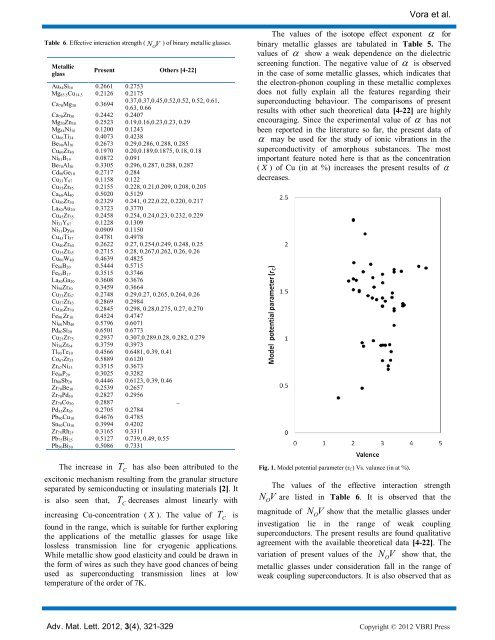Superconducting state parameters of binary metallic glasses
Superconducting state parameters of binary metallic glasses
Superconducting state parameters of binary metallic glasses
You also want an ePaper? Increase the reach of your titles
YUMPU automatically turns print PDFs into web optimized ePapers that Google loves.
Table 6. Effective interaction strength ( NOV Metallic<br />
glass<br />
Present Others [4-22]<br />
Au84Si16 0.2661 0.2753<br />
Mg85.5Cu14.5 0.2126 0.2175<br />
Ca70Mg30<br />
0.3694<br />
) <strong>of</strong> <strong>binary</strong> <strong>metallic</strong> <strong>glasses</strong>.<br />
0.37,0.37,0.45,0.52,0.52, 0.52, 0.61,<br />
0.63, 0.66<br />
Ca70Zn30 0.2442 0.2407<br />
Mg70Zn30 0.2523 0.19,0.16,0.23,0.23, 0.29<br />
Mg84Ni16 0.1200 0.1243<br />
Cu66Ti34 0.4073 0.4238<br />
Be90Al10 0.2673 0.29,0.286, 0.288, 0.285<br />
Cu60Zr40 0.1970 0.20,0.189,0.1875, 0.18, 0.18<br />
Ni81B19 0.0872 0.091<br />
Be70Al30 0.3305 0.296, 0.287, 0.288, 0.287<br />
Cd90Ge10 0.2717 0.284<br />
Cu33Y67 0.1158 0.122<br />
Cu55Zr45 0.2155 0.228, 0.21,0.209, 0.208, 0.205<br />
Ca60Al40 0.5020 0.5129<br />
Cu50Zr50 0.2329 0.241, 0.22,0.22, 0.220, 0.217<br />
La80Au20 0.3723 0.3770<br />
Cu45Zr55 0.2458 0.254, 0.24,0.23, 0.232, 0.229<br />
Ni33Y67 0.1228 0.1309<br />
Ni31Dy69 0.0909 0.1150<br />
Cu43Ti57 0.4781 0.4978<br />
Cu40Zr60 0.2622 0.27, 0.254,0.249, 0.248, 0.25<br />
Cu35Zr65 0.2715 0.28, 0.267,0.262, 0.26, 0.26<br />
Cu60W40 0.4639 0.4825<br />
Fe80B20 0.5444 0.5715<br />
Fe83B17 0.3515 0.3746<br />
La80Ga20 0.3608 0.3676<br />
Ni50Zr50 0.3459 0.3664<br />
Cu33Zr67 0.2748 0.29,0.27, 0.265, 0.264, 0.26<br />
Cu57Zr43 0.2869 0.2984<br />
Cu30Zr70 0.2845 0.298, 0.28,0.275, 0.27, 0.270<br />
Fe90 Zr10 0.4524 0.4747<br />
Ni60Nb40 0.5796 0.6071<br />
Pd80Si20 0.6501 0.6773<br />
Cu25Zr75 0.2937 0.307,0.289,0.28, 0.282, 0.279<br />
Ni36Zr64 0.3759 0.3973<br />
Tl90Te10 0.4566 0.6481, 0.39, 0.41<br />
Co67Zr33 0.5889 0.6120<br />
Zr67Ni33 0.3515 0.3673<br />
Fe80P20 0.3025 0.3282<br />
In80Sb20 0.4446 0.6123, 0.39, 0.46<br />
Zr70Be30 0.2539 0.2657<br />
Zr70Pd30 0.2827 0.2956<br />
Zr70Co30 0.2887 <br />
Pd35Zr65 0.2705 0.2784<br />
Pb90Cu10 0.4676 0.4785<br />
Sn90Cu10 0.3994 0.4202<br />
Zr75Rh25 0.3165 0.3311<br />
Pb75Bi25 0.5127 0.739, 0.49, 0.55<br />
Pb50Bi50 0.5086 0.7331<br />
The increase in T C has also been attributed to the<br />
excitonic mechanism resulting from the granular structure<br />
separated by semiconducting or insulating materials [2]. It<br />
is also seen that, TC decreases almost linearly with<br />
increasing Cu-concentration ( X ). The value <strong>of</strong> T C is<br />
found in the range, which is suitable for further exploring<br />
the applications <strong>of</strong> the <strong>metallic</strong> <strong>glasses</strong> for usage like<br />
lossless transmission line for cryogenic applications.<br />
While <strong>metallic</strong> show good elasticity and could be drawn in<br />
the form <strong>of</strong> wires as such they have good chances <strong>of</strong> being<br />
used as superconducting transmission lines at low<br />
temperature <strong>of</strong> the order <strong>of</strong> 7K.<br />
Vora et al.<br />
The values <strong>of</strong> the isotope effect exponent for<br />
<strong>binary</strong> <strong>metallic</strong> <strong>glasses</strong> are tabulated in Table 5. The<br />
values <strong>of</strong> show a weak dependence on the dielectric<br />
screening function. The negative value <strong>of</strong> is observed<br />
in the case <strong>of</strong> some <strong>metallic</strong> <strong>glasses</strong>, which indicates that<br />
the electron-phonon coupling in these <strong>metallic</strong> complexes<br />
does not fully explain all the features regarding their<br />
superconducting behaviour. The comparisons <strong>of</strong> present<br />
results with other such theoretical data [4-22] are highly<br />
encouraging. Since the experimental value <strong>of</strong> has not<br />
been reported in the literature so far, the present data <strong>of</strong><br />
may be used for the study <strong>of</strong> ionic vibrations in the<br />
superconductivity <strong>of</strong> amorphous substances. The most<br />
important feature noted here is that as the concentration<br />
( X ) <strong>of</strong> Cu (in at %) increases the present results <strong>of</strong> <br />
decreases.<br />
Fig. 1. Model potential parameter (rC) Vs. valance (in at %).<br />
The values <strong>of</strong> the effective interaction strength<br />
V are listed in Table 6. It is observed that the<br />
Adv. Mat. Lett. 2012, 3(4), 321-329 Copyright © 2012 VBRI Press<br />
N O<br />
N O<br />
magnitude <strong>of</strong> V show that the <strong>metallic</strong> <strong>glasses</strong> under<br />
investigation lie in the range <strong>of</strong> weak coupling<br />
superconductors. The present results are found qualitative<br />
agreement with the available theoretical data [4-22]. The<br />
variation <strong>of</strong> present values <strong>of</strong> the NO V show that, the<br />
<strong>metallic</strong> <strong>glasses</strong> under consideration fall in the range <strong>of</strong><br />
weak coupling superconductors. It is also observed that as
















